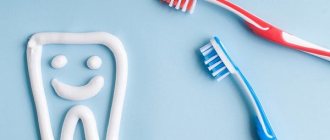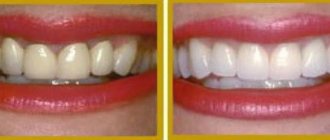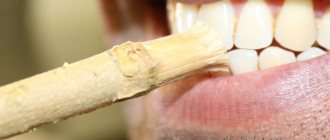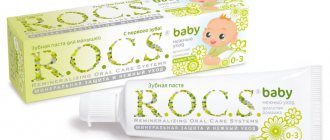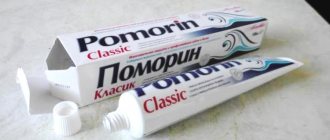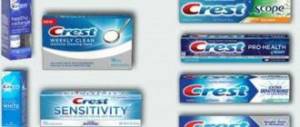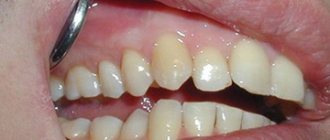Author of the article:
Soldatova Lyudmila Nikolaevna
Candidate of Medical Sciences, Professor of the Department of Clinical Dentistry of the St. Petersburg Medical and Social Institute, Chief Physician of the Alfa-Dent Dental Clinic, St. Petersburg
Cigarette plaque on teeth is an extremely unpleasant consequence of active smoking. It gradually accumulates on the enamel, causing its color to change.
When you abuse tobacco, your smile takes on a pronounced yellow or even dark brown tint, and unsightly stains appear on your teeth that cannot be removed with a brush.
The change in enamel color is a consequence of exposure to substances that are part of smoke, such as nicotine, phenolic and ammonia compounds, and tar. All of them firmly settle on the porous surface of the teeth, penetrating deeper and deeper over time, which leads to the fact that the yellowness becomes more and more pronounced.
The worse a smoker cares about oral health, the faster plaque forms, which ultimately leads not only to aesthetic problems, but also to deterioration in the quality of enamel.
If measures are not taken in a timely manner, the yellow plaque turns into gray-brown. This leads to inflammation of the gums and impaired blood circulation in them. Bleeding, periodontal disease, caries and tartar may occur. Further, the smoker may experience tooth loss, so it is worth paying attention and addressing the problem in a timely manner.
The effect of smoking on teeth color
Important! Cigarette smoke contains a huge list of substances and elements, including nicotine and various tars. With regular smoking, microparticles settle on the teeth and a specific yellowish plaque forms.
At the first stage, the problem is purely aesthetic in nature, but if it is not addressed, plaque leads to the formation of tartar, and also causes inflammation of the gums and contributes to the development of caries. The plaque caused by smoking initially has a yellow tint, but over time becomes darker to grayish-brown and black.
Gum inflammation caused by this harmful habit can become serious, accompanied by bleeding, gingivitis, periodontal disease and chronic bleeding gums. Smokers are also at risk of developing tooth decay. Almost all lovers of this habit have teeth in their mouths that require treatment. Their caries develops quickly, endlessly transmitted from tooth to tooth.
In addition, there are statistics according to which four out of ten smokers completely lose their teeth by age 65. Among non-smokers this figure is two times lower.
List of prohibited products
In the first two weeks, you need to treat your teeth especially carefully. Hot and cold food is prohibited; everything should be moderately warm. There is no need to expose the enamel to even mild acid, so you will have to exclude fermented milk products.
With a white diet, you eat everything that is light in color. Animal products include:
- white meat and fish,
- egg white,
- soft cheese (mild and without spices),
- fresh milk,
- butter.
The following herbal products are acceptable:
- rice,
- pearl barley,
- cereals,
- white beans,
- potato,
- pasta,
- flour products (only without sugar and coloring ingredients),
- light mushrooms (champignons or porcini),
- light vegetable oil,
- white sweet pepper,
- peeled cucumbers,
- bananas,
- white and clear drinks (non-alcoholic).
The remaining vegetables and fruits are divided into two groups: unacceptable and conditionally acceptable. For example, beets or carrots are prohibited in any form. Conditionally acceptable include those for which heat treatment is sufficient to destroy the acid and weak pigment. For example, boiled cabbage or sour baked apples without peel.
Do not use:
- dairy products;
- egg yolk;
- red fish;
- red meat;
- sausage and ham (contains dyes);
- light fruits (if they are sour and have peel);
- colored fruits and vegetables;
- greenery;
- unpeeled cucumbers;
- sweets;
- spices, sauces, vinegar;
- colored drinks (including coffee, black and even green tea);
- alcohol.
- In the first four days after bleaching, you must strictly follow the rules. From the 5th day you can allow yourself relaxations, but small ones. For example, drink green tea through a straw or fermented baked milk, then immediately brush your teeth or rinse your mouth.
It is advisable to adhere to a white diet for a month, the minimum required period is 14 days. At this time, it is not yet recommended to paint your lips, since accidentally getting gloss or lipstick on the enamel is equivalent to using a coloring product.
Features of plaque from tobacco smoke
Plaque that appears on teeth can be of different colors:
- yellow and brownish;
- white;
- black;
- green.
Important! The most harmless is a white coating. It forms on the teeth quite quickly, for example, overnight or during the day. The reason for its appearance is the food consumed, as well as bacteria and microbes that multiply on the surface of the teeth.
Such plaque, if removed in a timely manner, does not pose any particular danger. It can be removed during regular brushing with a toothbrush. Green plaque is rare and mainly appears due to damage to the pellicle (the protective layer of the tooth located on the surface of the enamel). Also, this shade of plaque can be caused by a fungal infection of the oral cavity.
Yellow and brown plaque appears due to tooth pigmentation caused by smoking, as well as from excessive consumption of strong tea and coffee. This type of plaque is difficult to remove on your own. The easiest way in such a situation is to have it professionally cleaned by a dentist. Black plaque is an advanced form of pigmentation, which initially had a yellow or brown tint.
When can you smoke after teeth whitening?
Smoking after teeth whitening in the first days is strictly prohibited. Resins from tobacco smoke settle on the enamel, contributing to the rapid formation of a new dark plaque. In addition, smoke always burns the teeth, even if the smoker himself does not feel the burn. And if he smokes in the cold, then the temperature difference in the oral cavity leads to microcracks.
Smoking after bleaching is contraindicated for at least two weeks, and it is better to endure without cigarettes for a month. This will help not harm your teeth while they are hypersensitive and vulnerable. Before bleaching, you should also abstain from tobacco for two weeks. In order to preserve your whiteness, you should quit smoking for good.
It is not easy to take all the precautions, but the results are worth it. With careful oral care and constant avoidance of cigarettes and coloring products, a spectacularly white smile can last more than a year, and possibly more than two years. If, after the mandatory two weeks, you return to smoking and your previous eating habits, then within a few months the surface of your teeth will turn yellow.
Ways to get rid of plaque
Some smokers believe that it is impossible to get rid of the yellow tint of teeth. This is wrong. It is quite possible to whiten yellowed enamel, and you can even try to do it at home. However, if the case is advanced, and the plaque has turned from yellowish to brown or even black, then folk remedies are likely to be ineffective. A dentist will help you thoroughly clean your teeth from old pigmentation.
Home whitening methods
When choosing methods for getting rid of plaque, you need to understand that home procedures will take much more time than professional cleaning at the dentist.
To remove plaque at home, you can use the following methods:
- Using baking soda. The abrasive properties of this substance allow you to effectively remove plaque and polish tooth enamel. To achieve results, you can use baking soda in its pure form or add it to your usual toothpaste. You can use this method no more than twice a week.
- Lemon peel. Rubbing the surface of the teeth with the crust of this fruit helps lighten the enamel.
- Cleaning with activated carbon. Crushed charcoal is applied to the brush and the teeth are cleaned with gentle movements. The method is highly effective, however, the efforts made should be controlled to avoid damage to the enamel.
- Using tea tree oil. This product is distinguished by its safety and has an additional antibacterial effect. After cleansing your teeth with regular toothpaste, apply a few drops of oil to your brush and gently brush your teeth again. Then rinse your mouth with water and a few drops of lemon. After the procedure, you may feel a slight numbness.
- Hydrogen peroxide. A few drops of peroxide solution are applied to a cotton swab and wiped over the teeth. After this, you need to perform hygiene with toothpaste and then rinse your mouth thoroughly. Peroxide has a pronounced effect, but has an adverse effect on the enamel.
- Factory products. Effective is the use of various whitening gels applied to the teeth using a special tray. Lightening agents in the form of strips have a similar effect. When using these devices, you must be careful and strictly follow the instructions in the instructions.
In order to avoid plaque caused by a bad habit, you need to brush your teeth after every cigarette you smoke. Unfortunately, this opportunity does not always exist. Regular use of home whitening methods will help get rid of fresh plaque and prevent it from acquiring a dark shade.
Attention! In addition to the above methods, it would be useful to include solid vegetables and some types of fruits in your diet, which help clean and brighten your teeth. These include: strawberries, apples, lemons, celery and carrots.
Features of whitening with soda
When wondering how to remove plaque on teeth after smoking, many people opt for baking soda.
The method is really effective, although there are contraindications, such as:
- tendency to bleeding gums;
- increased sensitivity of enamel;
- enamel pathologies (fluorosis, hypoplasia);
- carious infections.
If the listed contraindications are absent, you can try this type of whitening. Procedure steps:
- Prepare soda in the form of a dry powder or a paste-like mixture with water. You will also need a toothbrush.
- Baking soda must be applied to the toothbrush (if using dry powder, the brush must be moistened with water).
- Brush your teeth, being careful and trying not to get it on the oral mucosa.
- Rinse your teeth thoroughly.
This method should not be used more than twice a week. Baking soda can be used not in its pure form, but added to regular toothpaste.
Professional teeth cleaning after smoking
Advanced forms of plaque on teeth are best left to the dentist. A professional approach to lightening enamel after smoking includes two types of procedures:
- Professional hygiene. The procedure is carried out using soft abrasive cleaning and ultrasonic methods. During the manipulation process, teeth are even removed from old plaque and tartar.
- Enamel whitening. This method is used when the natural color of the teeth is not satisfactory, and the patient wants to have a perfectly snow-white smile.
Sometimes combined methods are used, combining them with subsequent remineralization of tooth enamel.
What is included in the ANNUAL Dental Care for Smokers program?
- Regular dental examinations
(4 examinations per year) to prevent diseases of the teeth and gums or treat them at an early stage. - Professional hygiene
according to an optimal schedule (4 procedures per year). - Remineralization of teeth
(4 procedures per year). - Applying therapeutic dressings
to periodontal tissue at each scheduled visit. - Selection of special products
for home hygiene of the entire oral cavity.
Have you had your teeth whitened? What to pay attention to after the procedure? Follow the recommendations of our dentists!
Prevention
It is always easier to prevent pathology than to treat it. In order to avoid the appearance of plaque, it is best to get rid of the bad habit of smoking. If this cannot be done, then you need to at least minimize the number of cigarettes you smoke. Additional preventive measures are:
- thorough dental hygiene at least twice a day using a toothbrush, floss and mouthwash;
- timely replacement of the toothbrush;
- rinsing the mouth after every meal or smoking;
- control over the amount of coffee and strong tea consumed;
- alternating different types of toothpaste;
- regular oral hygiene at the dentist.
It is better to solve the problem at the stage while the above simple recommendations are effective. If you do not give up the bad habit, as well as neglect preventive measures, then plaque after smoking can lead to serious oral diseases.
Category Hygiene Published by Mister stomatolog
General recommendations
To keep your teeth white and healthy, you not only need to whiten periodically, but also follow these rules:
- brush your teeth at least 2 times a day, thoroughly cleaning all surfaces of the teeth and spending at least 5 minutes on the procedure;
- use medicated paste constantly and periodically alternating it with a special whitening paste - we brush our teeth with a regular paste for 3 months and with a special whitening paste for 1 month;
- limit the consumption of strong tea, coffee, carbonated drinks and other products that stain tooth enamel;
- reduce consumption of foods containing high concentrations of sugar;
- give up smoking - only by completely giving up smoking can you achieve whiter teeth, otherwise you will have to carry out whitening constantly, and the result will get worse every year.
Whitening teeth at home
If you decide to whiten your teeth after smoking at home, you will have to work hard. Regular toothpaste, no matter how good and expensive it is, will never be able to cope with yellow nicotine plaque on its own.
To lighten your teeth at home, you can use proven “grandmother’s” remedies, buy special kits at the pharmacy and, of course, be patient. To achieve a visible effect, you will need to regularly use the chosen product for several weeks or even more.
More videos about whitening
Don't know how to whiten your teeth after smoking? Use the most popular folk remedies or find out what procedures modern dentistry can offer you.
There are unknown risks associated with using the recommendations in this article and achieving the desired results. You decide to apply these recommendations at your own risk.
DO YOU WANT TO QUIT SMOKING?
Then you need a strategy for quitting cigarettes. With its help it will be much easier to quit.
The first thing inhaled tobacco smoke encounters on its way is our mouth. Smoker's dental plaque is one of the visible problems and consequences that await any smoker. In reality, everything is much more serious.
With the next puff, hot air enters the smoker’s mouth, followed by cold, sharp temperature changes that damage the enamel. Cracks appear on the teeth, which accumulate toxic substances. Visually, this takes the form of a yellow coating, but in an experienced smoker it turns brown.
Smoker's plaque is an accumulation of deposits that take on a dirty brown hue. Smoking deposits, unlike normal deposits that build up throughout the day, cannot be removed with normal daily oral hygiene products.
